|
|
|
|
|
Oil On
Canvas, Real Flavor of Old Masters
|
|

|
ARTWORKS
INDEX
A B C D E F G H I J K L M N O P Q R S T U V W X Y Z |
ARTISTS
INDEX
A B C D E F G H I J K L M N O P Q R S T U V W X Y Z |
|
|
| | |
|
|
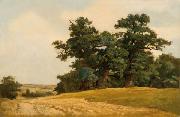 |
Eugen Ducker -- Click Here
|
|
was a romanticist Baltic German painter.
He was born in Kuressaare, Estonia, on 29 January 1841 in the Julian calendar (10 February 1841 according to the Gregorian calendar) and died on 6 December 1916 in Dusseldorf, where he developed almost all his career. A notable student of his was the Norwegian landscape painter Adelsteen Normann who studied with Ducker from 1869 to 1872. |
|
|
|
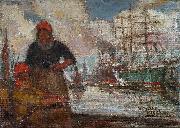 |
Eugeen Van Mieghem -- Click Here
|
|
(1 October 1875-1930) was a Belgian artist born in the port of Antwerp. As a boy Van Mieghem was confronted with the harsh reality of life at the waterfront.
Even at primary school he showed a talent for drawing. He was introduced to the work of Vincent van Gogh, Georges Seurat, Camille Pissarro, Henri de Toulouse-Lautrec and others at an exhibition organised by Flemish painter and architect Henry van de Velde at the Antwerp Academy around 1892. He attended the Antwerp Academy but was sent from school because his conservative teachers disliked his subject matter and his free, spontaneous way with it. He threw his lot in with progressive political and cultural movements, and joined an anarchist group. By the early 1900s was recognized as one of the most promising young artists of the Antwerp school. He would never renounce his idealism. He became the artist of the typical harbour folk: sack porters, sack makers, emigrants, dockers, bargees, and tramps.
Van Mieghem had his first taste of real success at La Libre Esthetique in Brussels, where his pastels and drawings hung alongside works by French impressionists such as Claude Monet, Paul Cezanne, Camille Pissarro, Jean Renoir and Edouard Vuillard.
|
|
 |
Ettore Tito -- Click Here
|
|
(17 December 1859-26 June 1941) was an Italian artist particularly known for his paintings of contemporary life and landscapes in Venice and the surrounding region. He trained at the Accademia di Belle Arti in Venice and from 1894 to 1927 was the Professor of Painting there. Tito exhibited widely and was awarded the Grand Prize in painting at the 1915 Panama CPacific International Exposition in San Francisco. In 1926 he was made a member of the Royal Academy of Italy. Tito was born in Castellammare di Stabia in the province of Naples and died in Venice, the city which was his home for most of his life. |
|
|
|
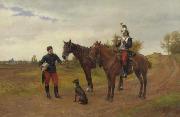 |
etienne Prosper Berne-Bellecour -- Click Here
|
|
1838-1910 |
|
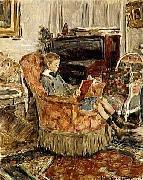 |
Etienne Moreau-Nelaton -- Click Here
|
|
Adolphe Etienne Auguste Moreau-Nelaton (2 December 1859, Paris- 25 April 1927, Paris) was a French painter, art collector and art historian. His large collection is today held in its entirety by National French museums.
Moreau-Nelaton's family's art collecting began with his grandfather Adolphe Moreau (1800-59). As a stockbroker he possessed ample capital with which to buy the work of artists with whom he was personally acquainted, including Eugene Delacroix and Alexandre-Gabriel Decamps. Moreau-Nelaton's father, who was also named Adolphe Moureau (1827-82), was a high government official and led the railroad company Chemins de fer de l'Est. In 1856 he married the ceramic artist Camille Nelaton (1840-97), with whom he further expanded the family's collection. |
|
|
|
|
|
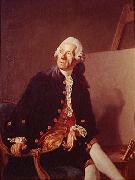 |
Etienne Aubry -- Click Here
|
|
Etienne Aubry, who was born at Versailles in 1746, studied under J. A. Silvestre and Joseph Vien, and soon became noted for his portraits and genre subjects. He exhibited several works of great merit at the Salon; but his life was cut short in its prime in 1781, in which year he had exhibited the 'Parting of Coriolanus from his Wife.' |
|
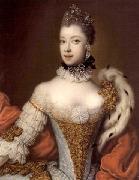 |
Esther Denner -- Click Here
|
|
painted Portrait of Queen Charlotte in 1761 |
|
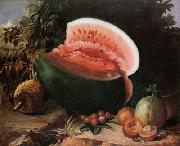 |
Estevao Silva -- Click Here
|
|
Estevao Roberto da Silva (Rio de Janeiro, c. 1844 - idem, 9 de novembro de 1891) foi um importante pintor e professor brasileiro da segunda metade do seculo XIX. Primeiro pintor negro de destaque formado pela Academia Imperial de Belas Artes, notabilizou-se por suas naturezas-mortas, sendo considerado um dos maiores expoentes da arte brasileira no genero. |
|
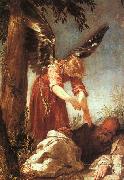 |
ESCALANTE, Juan Antonio Frias y -- Click Here
|
|
Spanish painter, Madrid school (b. 1633, Cordoba, d. 1670, Madrid) |
|
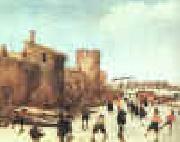 |
Esaias Van de Velde -- Click Here
|
|
1591-1630
Dutch
Esaias Van de Velde Gallery
Painter, draughtsman and etcher. He probably received his earliest training from his father. It is also possible that he studied with the Antwerp painter Gillis van Coninxloo, who moved to Amsterdam in 1595 (ten years after Esaias father). He may also have trained with David Vinckboons, whose work shows similarities with that of Esaias. Esaias became a member of the Haarlem Guild of St Luke in 1612, the same year as Willem Buytewech and the landscape painter Hercules Segers. During this Haarlem period Esaias had two pupils, Jan van Goyen and Pieter de Neijn (1597-1639), but by 1618 he had moved with his family to The Hague, where he joined the Guild of St Luke in October of that year. |
|
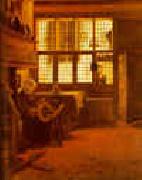 |
Esaias Boursse -- Click Here
|
|
1631-1672 Dutch
Dutch painter and draughtsman. Boursse was the son of Walloon parents, Jacques Boursse and Anne de Forest. A testimony of 23 July 1658 states that Esaias brother Jan provided for his artistic training. There is nothing to confirm a view of the early 20th-century scholars Bode, Bredius and Valentiner that Boursse was a pupil of Rembrandt, although the two artists may have had some contact, since Rembrandt lived near Jan in Amsterdam. According to an inventory of 24 November 1671, Jan collected a number of paintings, drawings and etchings by Rembrandt. |
|
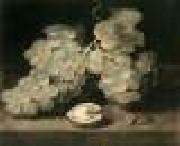 |
ES, Jacob van -- Click Here
|
|
Flemish painter (b. ca. 1596, Antwerpen, d. 1666, Antwerpen)
Flemish painter. Together with Osias Beert and Clara Peeters, he was one of the leading representatives of the archaizing trend in Flemish still-lifes. His birthplace is known from the text on an engraving by Wenceslaus Hollar after a painting by Jan Meyssens (1612-70). Van Es became a master in Antwerp in 1617 but did not join the Guild of St Luke until 1645. Jacob Gillis and Jan van Thiene were his pupils in 1621 and 1623 respectively. He enjoyed a certain esteem among fellow artists, for Jacob Jordaens, Cornelis Schut the elder and Deodaat del Monte were godfathers to his children. Numerous mentions of works by van Es in inventories of 17th-century Antwerp collectors further testify to his success |
|
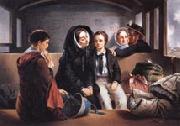 |
Erskine Nicol -- Click Here
|
|
British Genre Painter , (1825-1904)
was an Irish/Scottish painter. A student of William Allan, Nicol taught in Dublin, Ireland, from 1845-50, at the height of the Irish famine, and considered himself as much Irish as he was Scottish. Much of his work portrays the injustices inflicted upon the Irish population during the 19th century. He was made an Associate of the Royal Scottish Academy in 1855 and an Academician in 1859. Nicol exhibited at the Royal Academy and was made an Associate of the Royal Academy in 1866 |
|
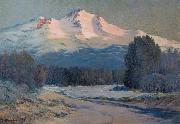 |
Ernst William Christmas -- Click Here
|
|
(1863-1918) was an Australian painter. He was born near Adelaide, South Australia in 1863 and studied art in Adelaide, Sydney and in London. He painted widely in England, exhibiting in the early years of the century at the Royal Academy, the Royal Institute of Oil Painters, the Royal Society of British Artists, the Royal Glasgow Institute of Fine Arts and in the provinces.
He was elected to the British Royal British Academy in 1909. In 1910-11, he painted mountains and lakes in Argentina and Chile. He lived in San Francisco around 1900 and again around 1915. He was an avid traveller, but spent the last two years of his life in Hawaii, where he painted landscapes including dramatic volcano scenes. Ernest William Christmas died in Honolulu in 1918.
|
|
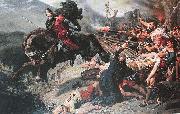 |
Ernst Stuckelberg -- Click Here
|
|
Ernst Stuckelberg
1831-1901
|
|
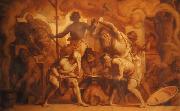 |
Ernst Sigismund Kirchbach -- Click Here
|
|
painted The Forge of Vulcan in between 1869 and 1875 |
|
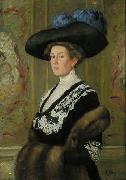 |
Ernst Oppler -- Click Here
|
|
1867, Hannover - 1929, Berlin, a Jewish German painter and etcher; elder brother of Alexander. |
|
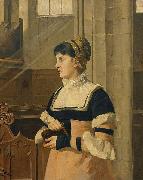 |
Ernst Meisel -- Click Here
|
|
painted Gretchen beim Kirchgang in 1894 |
|
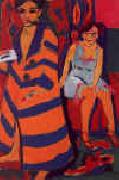 |
Ernst Ludwig Kirchner -- Click Here
|
|
German Expressionist Painter and Sculptor, 1880-1938 was a German expressionist painter and printmaker and one of the founders of the artists group Die Brucke or "The Bridge", a key group leading to the foundation of Expressionism in 20th century art. He volunteered for army service in the First World War, but soon suffered a breakdown and was discharged. In 1933, his work was branded as "degenerate" by the Nazis and in 1937 over 600 of his works were sold or destroyed. In 1938 he committed suicide. In 1913, the first public showing of Kirchner's work took place at the Armory Show, which was also the first major display of modern art in America. In 1921, U.S. museums began to acquire his work and did so increasingly thereafter. His first solo show was at the Detroit Institute of Arts in 1937. In 1992, the National Gallery of Art, Washington, held a monographic show, using its existing collection; a major international loan exhibition took place in 2003. In November 2006 at Christie's, Kirchner's Street Scene, Berlin (1913) fetched $38 million, a record for the artist. |
|
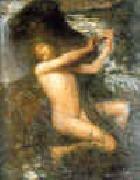 |
Ernst Josephson -- Click Here
|
|
1851-1906
Swedish
Ernst Josephson Gallery
was a Swedish painter from a prominent Jewish family, whose main work was done on portraits and paintings of folk life.
He did his art studies in Italy, France and the Netherlands, among others, and is reputed to have said at the age of 20: "I will become Sweden's Rembrandt or die."
However, his life was marred by illness. He contracted syphilis at a relatively young age, and in 1888 he became mentally ill during a visit to Brittany, having religious hallucinations and believing that he was God and Christ.
He was later taken to hospital in Uppsala and diagnosed with schizophrenia, but continued working throughout his disease, often while in a trance-like state.
He also wrote poetry, in the collections Svarta rosor (1888, Black Roses) and Gula rosor (1896, Yellow Roses). His main work, Strömkarlen (1884, the Nix), was refused by the Swedish National Museum in Stockholm - however, Prince Eugen, Duke of Narke, bought the painting in fury over the decision.
Grandfather of Erland Josephson. |
|
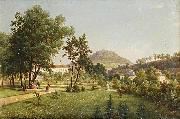 |
Ernst Gustav Doerell -- Click Here
|
|
painted A View of the Doubravka from the Teplice Chateau Park in 1832 - 1877 |
|
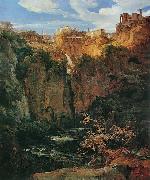 |
Ernst Fries -- Click Here
|
|
(22 June 1801 Heidelberg - 11 October 1833 Karlsruhe) was a German painter.
Fries was a pupil of Karl Kuntz at Karlsruhe, and afterwards studied in Munich and in Italy. Examples of his work are: eA View of Tivoli, Sorrento and the House of Tasso, The Waterfall of Liris at Isola di Sora, The Castle of Massa, and A View of Heidelberg.
|
|
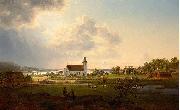 |
Ernfried Wahlqvist -- Click Here
|
|
painted Landscape with a church by a river in 1863 |
|
|
|
|
|
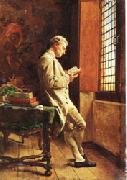 |
Ernest Meissonier -- Click Here
|
|
Lyons 1815 - Paris 1891.
French Academic Painter, 1815-1891.
Lyons 1815 - Paris 1891. French Academic Painter, 1815-1891. French genre and military painter. His study of the Dutch masters was evident in his first Salon-exhibited painting, A Visit to the Burgomaster (1834). His small genre paintings are meticulous as to furnishings and costumes. Among Meissonier's battle scenes, chiefly of the Napoleonic Wars, are Napoleon I with His Staff (Louvre) and Friedland, 1807 (Metropolitan Mus.). |
|
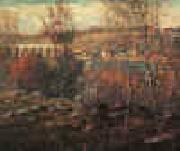 |
Ernest Lawson -- Click Here
|
|
1873-1939
Ernest Lawson Galleries
Ernest Lawson (March 22, 1873 ?C December 18, 1939) was a Canadian-American painter and a member of The Eight, a group of artists which included the group's leader Robert Henri, Everett Shinn, John Sloan, Arthur B. Davies, Maurice Prendergast, George Luks, and William J. Glackens.
Lawson was born in Halifax, Nova Scotia. Though Lawson mostly painted landscapes, he also did some realistic urban scenes which were shown at the 1908 exihibition of The Eight. His painting style is heavily influenced by Impressionism, especially the style of John Henry Twachtman, Alfred Sisley, and J. Alden Weir.
Lawson exhibited as a member of the Canadian Art Club from 1911 to 1915. He died in Miami Beach, Florida in 1939. |
|
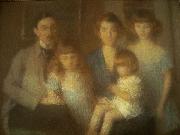 |
Ernest Laurent -- Click Here
|
|
(June 8, 1859 -- June 25, 1929) was a French painter and printmaker. He was born in Gentilly and died in Bievre.
Laurent was a neo-impressionist artist whose main influences were his instructor Ernest Hebert and his friend Georges Seurat. Laurent took second prize in the Prix de Rome in 1889 and in 1890, Laurent arrived in Rome, where Hebert remained Director of the Academie de France. From Rome, he went to Assisi where he underwent a mystical experience. It would profoundly influence his art. The work he returned to Paris from Assisi was noted for its religious themes.
Over time, profound religious devotion influenced his artistic motif and religious symbolism and scenery crept into his work. This aspect of his life ran counter to Seurat's materialism and the two parted ways.
|
|
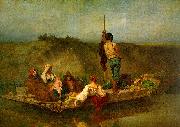 |
Ernest Hebert -- Click Here
|
|
1817-1908
French
Ernest Hebert Gallery
He was born in Grenoble and died in La Tronche. His painting Mal aria was exhibited in the Salon of 1850-1851, and now hangs in the Musee d Orsay, Paris. Painted in a Romantic style, it depicts a family of Italian peasants escaping an epidemic by raft, a scene inspired by events Hebert had witnessed while in Italy.
His student Paul Trouillebert was an important artist of the Barbizon School.
The artist house is preserved in the Musee Hebert in the VIe arrondissement of Paris. There is another museum near Grenoble. |
|
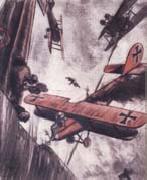 |
Ernest Fuhr -- Click Here
|
|
A popular illustrator of the period and this is classic patriotic art . 1874-1933
|
|
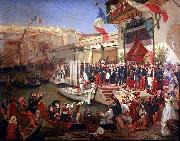 |
Ernest Francis Vacherot -- Click Here
|
|
painted Arrival of Marshal Randon in Algiers in 1857. |
|
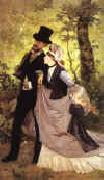 |
Ernest Duez -- Click Here
|
|
1843-1896
French
Ernest Duez Location
French painter. He studied under Isidore-Alexandre-Augustin Pils and made his debut at the Salon in 1868. One of his earliest paintings, The Honeymoon (1873), caused a scandal at the Salon owing to its depiction of two lovers in modern dress walking through a sunlit forest. His triptych St Cuthbert (1879; Paris, Pompidou) was hailed as a masterpiece of modern art and bought by the State for the Musee du Luxembourg in Paris. The painting depicts the stages of St Cuthbert life, from child to hermit. Contemporary viewers were struck by the artist use of a real landscape setting, based on Villerville in Normandy where Duez spent much of his time. In addition to genre, religious and history paintings, in 1876 he began to produce portraits: Alphonse de Neuville (1880; Versailles, Cheteau) is a typical example. His brooding, suggestive portrait of Mme Duez (1877; see Montrosier, 1896, p. 429) shows the influence of Symbolism. However, he soon returned to painting works that were essentially landscapes, such as the decorative panel Virgil Seeking Inspiration in the Woods (1888) for the Sorbonne and a pair of allegorical figures, Botany and Physics (1892), for the Hetel de Ville in Paris. He also devoted time to applied art, producing a variety of textile designs. His work was praised for its adept use of colour and for bringing what were seen as modern techniques to traditional subjects. |
|
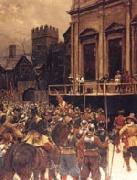 |
Ernest Crofts -- Click Here
|
|
English Painter , b. 15 September 1847- d. 19 March 1911
was an English painter who specialized in battle scenes. Ernest Crofts, RA lived at 'The Green' which he helped to re-design, next to Blythburgh church in Suffolk. |
|
|
|
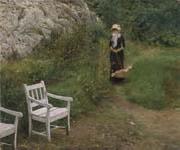 |
Erik Werenskiold -- Click Here
|
|
Norwegian Realist Painter, 1855-1936 |
|
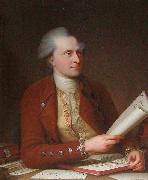 |
Erik Pauelsen -- Click Here
|
|
painted Ove Malling in 1700s |
|
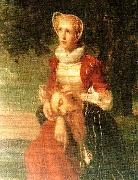 |
Erik Johan lofgren -- Click Here
|
|
Erik Johan Löfgren (15. lokakuuta 1825 Turku -- 10. joulukuuta 1884) oli suomalainen taidemaalari.
Löfgrenin vanhemmat olivat kauppias Johan Gabriel Löfgren ja Katarina Erikintytär o.s. Vahlsten. Hän opiskeli T. J. Leglerin johdolla Ruotsin kuninkaallisessa taideakatemiassa Tukholmassa 1842?C1850 ja sitten D??sseldorfin taideakatemiassa O. Mengelbergin ja F. Th. Hildebrandtin johdolla 1853?C1858.
Löfgren toimi taulujen restauroijana Tukholmassa 1842?C1853 ja myöhemmin 1870-luvulla hän oli opettajana Helsingin yliopiston piirustussalissa. Hänen maalaustyylinsä oli lyyrisen romanttista ja hän maalasi muotokuvia sekä historian tapahtumista aiheensa saaneita maalauksia. |
|
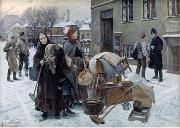 |
Erik Henningsen -- Click Here
|
|
(29 August 1855 - 28 November 1930) was a Danish painter and illustrator. He is best known for his Social Realist paintings of poor and exposed groups in the 1880s and 1890s. He was the younger brother of Frants Henningsen who was also a painter.
Erik Henningsen was born on 29 August 1855 in Copenhagen to Frants Ludvig Henningsen (1820-1869), a grocer, and Hilda Charlotte Christine ne Schou (1824-1880). He showed an early artistic talent and was articled to decorative painter A. Hellesen. He also took drawing lessons privately with C. V. Nielsen and was admitted to the Royal Danish Academy of Fine Arts in 1873. He graduated in 1877 and won several awards and distinctions, including the Academy's Annual Medal in 1887 and 1890, the Ancher Prize in 1889. |
|
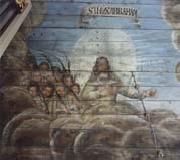 |
Erik Eriksson Grijs -- Click Here
|
|
omkring 1650-1720 |
|
|
|
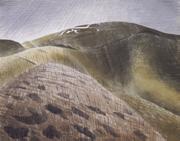 |
Eric Ravilious -- Click Here
|
|
British Painter, ca.1903-1942
English painter, wood-engraver and designer. He was educated at Eastbourne School of Art and then at the Royal College of Art (1922-5), where he was taught by Paul Nash and became close friends with Edward Bawden. His early works included the refectory mural (destr. 1940) in Morley College, London, and wood-engravings in the tradition of Bewick for the Golden Cockerel, Curwen and Nonesuch presses. In the 1930s he began painting larger compositions in a wider range of colour, and this led him to use lithography for such illustrations as those for High Street. Ravilious also produced designs for Wedgwood, including the celebration mug (1936) for the coronation of King Edward VIII, which was withdrawn and revised for the coronations of George VI and Elizabeth II; the Alphabet mug (1937); the Afternoon Tea (1937), Travel (1938) and Garden Implements (1939) china sets; and the Boat Race Day cup (1938). He also designed glass for Stuart Crystal (1934), furniture for Dunbar Hay (1936) and graphic work for advertisements for London Transport and others. Despite his success as a designer, Ravilious concentrated increasingly on watercolours. His landscapes and rural interiors often featured the downland and coast of southern England; haunting and lyrical, these works show a world in suspense and often feature chalk hill figures, as in Train Landscape (c. 1939; Aberdeen, A.G.) and empty rooms. |
|
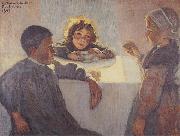 |
Eric Forbes-Robertson -- Click Here
|
|
(1865-1935).
a figure and landscape painter
a figure and landscape painter.was a Scottish painter of landscapes, flowers, and foliage, with children. He was a cousin of James Hornell. He was born in Australia, of Scottish parents, and he was brought up and lived practically all his life in Scotland, at Kirkcudbright. He studied for three years at the art school at Edinburgh, and for two years at Antwerp under Professor Verlat. Returning from Antwerp in 1885, he met George Henry and associated himself with the Glasgow School. Hornel and Henry collaborated upon "The Druids Bringing In The Mistletoe" (1890), a procession of priests bringing in the sacred mistletoe, gorgeous with polychrome and gold. The two worked side by side to achieve decorative splendor of color, Hornel boldly and freely employing texture effects produced by loading and scraping, roughening, smoothing, and staining. In 1893-94 the two artists spent a year and a half in Japan, where Hornel learned much about decorative design and spacing. Towards the close of the nineties his colors, while preserving their glow and richness, became more refined and more atmospheric, and his drawing more naturalistic, combining sensuous appeal with emotional and poetic significance. In 1901 he declined election to the Royal Scottish Academy. In 1901 he acquired Broughton House, a townhouse and garden in Kirkcudbright, which was his main residence for the rest of his life. |
|
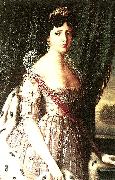 |
eric bogislaus skjoldebrand -- Click Here
|
|
1873-1888
Swedish Artist. |
|
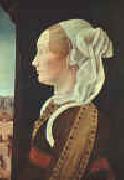 |
Ercole Roberti -- Click Here
|
|
1456-1496
Italian
Ercole Roberti Gallery
Ercole de' Roberti (c. 1451 ?C 1496), also known as Ercole Ferrarese or Ercole da Ferrara, was an Italian artist of the Early Renaissance and the School of Ferrara. He was profiled in Vasari's Le Vite delle pi?? eccellenti pittori, scultori, ed architettori.
The son of the doorkeeper at the Este castle, Ercole later held the position of court artist for the Este family in Ferrara. According to Vasari:
By 1473, when he was 17, Ercole had left Ferrara and was working in Bologna in the studio of Francesco del Cossa. (According to Vasari, Ercole also apprenticed under Lorenzo Costa in Bologna, but this seems unlikely as he was Lorenzo's senior by seveal years). He is known to have collaborated in the frescoes of Palazzo Schifanoia.
Ercole's first mature works are his contributions to the Griffoni Chapel for the San Petronio Basilica in Bologna: a predella depicting the Miracles of St Vincent Ferrer (c.1473) (now in the Pinacoteca of the Vatican), and lateral pilasters for the altarpiece commissioned from del Cossa.
In 1480, Ercole created a large altarpiece with a Madonna and Child Enthroned with Saints for Santa Maria in Porto in Ravenna, which is now in the Brera, Milan. Portraits of Giovanni II Bentivoglio and Ginevra Bentivoglio attributed to Ercole de' Roberti (c. 1480) are in the National Gallery of Art, Washington, D.C.
Ercole succeeded Cosm?? Tura as court painter to the Este family in Ferrara around 1486. His role apparently went far beyond making art: he accompanied Alfonso d'Este on a papal visit to Rome, served as wardrobe manager for Isabella d'Este's wedding in Mantua, and may even have made salamis.
A painting of Portia and Brutus (c. 1486-90), believed to be painted for Eleonora of Aragon, duchess of Ferrara, is in the Kimbell Art Museum, Fort Worth, Texas. Ercole's painting of Saint Jerome in the Wilderness from this period is in the collection of the J. Paul Getty Museum, Los Angeles. |
|
 |
Ercole de Roberti -- Click Here
|
|
Ferrara ca 1451/56-1496
was an Italian artist of the Early Renaissance and the School of Ferrara. He was profiled in Vasari's Le Vite delle pi?? eccellenti pittori, scultori, ed architettori. The son of the doorkeeper at the Este castle, Ercole later held the position of court artist for the Este family in Ferrara. According to Vasari: Ercole had an extraordinary love of wine, and his frequent drunkenness did much to shorten his life, which he had enjoyed without any accident up to the age of forty, when he was smitten one day by apoplexy, which made an end of him in a short time. Paintings by Ercole are rare. |
|
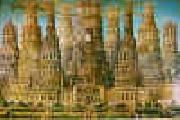 |
Erastus Salisbury Field -- Click Here
|
|
1805-1900
American painter. He studied with Samuel F. B. Morse in New York during the winter of 1824-5. On his return to the rural isolation of Leverett, MA, he painted his earliest known work, the portrait of his grandmother Elizabeth Billings Ashley (Springfield, MA, Mus. F.A.). His career as an itinerant portrait painter began in 1826, most of his commissions coming through a network of family associations in western Massachusetts and Connecticut. The portraits of 1836-40 are considered his best. From 1841 he lived mainly in New York, where he expanded his subject-matter to include landscapes and American history pictures. There he presumably studied photography, for on his return to Massachusetts he advertised himself as a daguerreotypist. His few portraits painted after 1841 are copied from his own photographs and lack the expressive characterization and decorative power of his earlier work. From 1865 to 1885 his paintings were based primarily on biblical and patriotic themes. The Historical Monument of the American Republic (1867-88; Springfield, MA, Mus. F.A.) stands alone in American folk art in size (2.82*3.89 m), scope and imaginative vision. Inspired by plans for a national celebration of the centennial of the USA in 1876, Field painted an architectural fantasy of eight towers linked by railway bridges and trains at the tops, with the history of the USA in low-relief sculpture on the exterior surfaces of the towers. Field added two more towers to the painting in 1888 and thereafter retired. |
|
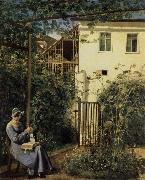 |
Erasmus Ritter von Engert -- Click Here
|
|
Austrian, 1796-1871 |
|
 |
Erasmus Quellinus -- Click Here
|
|
1607-1678 Flemish Erasmus Quellinus Gallery |
|
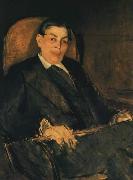 |
Eouard Manet -- Click Here
|
|
He was a French painter. One of the first 19th-century artists to approach modern and postmodern-life subjects, he was a pivotal figure in the transition from Realism to Impressionism.
His early masterworks, The Luncheon on the Grass (Le dejeuner sur l'herbe) and Olympia, engendered great controversy and served as rallying points for the young painters who would create Impressionism. Today, these are considered watershed paintings that mark the genesis of modern art. |
|
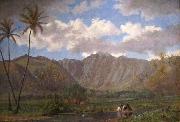 |
Enoch Wood Perry, Jr. -- Click Here
|
|
(1831-1915) was a painter from the United States.
Perry was born in Boston on July 31, 1831. His father was Enoch Wood Perry, and mother was Hannah Knapp Dole. His maternal grandparents were Samuel Dole and Katherine Wigglesworth. The family moved to New Orleans with his family as a teenager in 1848 and attended its public schools. After working several years as a clerk in a commission house, Perry began formal art education. In 1852 he went to Europe for four years and studied with Emanuel Leutze at the Desseldorf Academy, Thomas Couture in Paris, and in Rome.Perry served as the U.S. Consul to Venice between 1856 and 1858. Upon returning to America, he opened a studio in Philadelphia. |
|
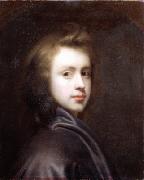 |
Enoch Seeman -- Click Here
|
|
Enoch Seeman the Younger was born in Danzig, now Gdansk, Poland, around 1694. His father, also Enoch was born around 1661, and the Seeman family were painters.
Having been brought to London from his home of Flanders by his father in 1704, the younger Seeman's painting career as we know it began with a group portrait of the Bisset family in the style of the portraitist Godfrey Kneller, now held at Castle Forbes in Grampian, Scotland, and dated by an inscription 1708.
As a painter to the British royal court Seeman the Younger completed portraits of George I, in 1730, in the robes of his coronation and of George II some years later. The first of these pictures is held at the Middle Temple in London, England, and the second is at Windsor Castle in Berkshire, England, part of the royal collection.
In 1734, Seeman painted a portrait of Jane Pratt Taylor, daughter of Lord Chief Justice John Pratt. The portrait was sent to William Byrd, II of Westover, in Virginia, where it became part of the largest colonial portrait collection of the early eighteenth-century. The painting is now part of the collection of the Virginia Historical Society.
The Yale University Art Gallery owns a portrait of Elihu Yale in 1717 by Seeman and the Metropolitan Museum in New York, USA owns his rendering of Sir James Dashwood, described by the Grove Dictionary of Art as 'Exceptionally lively'. Also by Seeman the younger, Abraham Tucker in 1739 at the National Portrait Gallery in London, England, and various copies of sixteenth and seventeenth century portraits. The National Trust owns two examples of this set of his work - at Dunham Massey in Cheshire, England, a copy of a portrait of Lady Diana Cecil, and at Belton House in Lincolnshire, England, of Lady Cust and her Nine Children. |
|
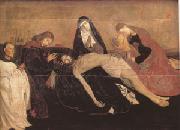 |
Enguerrand Quarton -- Click Here
|
|
active in Provence 1444-1466 |
|
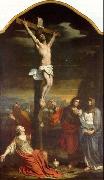 |
Englebert Fisen -- Click Here
|
|
(1655 -1733 ) - Painter |
|
 |
ENGELBRECHTSZ., Cornelis -- Click Here
|
|
Dutch painter (b. 1468, Leiden, d. 1533, Leiden).
|
|
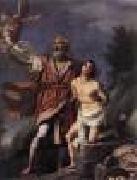 |
EMPOLI -- Click Here
|
|
Italian painter, Florentine school (b. 1551, Firenze, d. 1640, Firenze) |
|
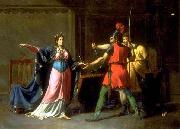 |
Emmanuel Herman Joseph Wallet -- Click Here
|
|
painted Fredegonde distribuant des poignards a deux assassins in 19th century
|
|
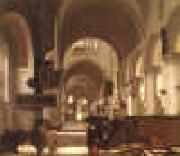 |
Emmanuel de Witte -- Click Here
|
|
Dutch
1617-1692
Emmanuel de Witte Gallery
Dutch painter. He was one of the last and, with Pieter Saenredam, one of the most accomplished 17th-century artists who specialized in representing church interiors. He trained with Evert van Aelst (1602-57) in Delft and in 1636 joined the Guild of St Luke at Alkmaar, but he was recorded in Rotterdam in the summers of 1639 and 1640. In October 1641 his daughter was baptized in Delft, where he entered the Guild of St Luke in June 1642 and lived for a decade, moving to Amsterdam c. 1652. He began his long career as an unpromising figure painter, as can be seen in the Vertumnus and Pomona (1644) and two small pendant portraits (1648; all Rotterdam, Mus. Boymans-van Beuningen). |
|
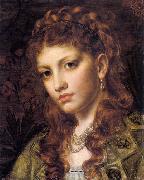 |
Emma Sandys -- Click Here
|
|
Emma Sandys (born Mary Ann Emma Sands) (1843 - 1877) was a 19th-century English painter.
Sandys was born in Norwich, England in 1843. She was taught by her father, Anthony Sands, and worked in portraits in both oil and chalk, often in medieval or period dress. Her earliest dated painting is marked 1863 and she exhibited her works in both London and Norwich between 1867 and 1874.
Sandys did most of her work around Norwich but may have spent time in the studio of her brother, Frederick Sandys, in London.
She died Norwich in November 1877. |
|
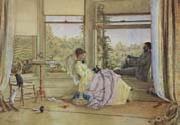 |
Emma Minnie Boyd -- Click Here
|
|
Australian Painter, 1858-1936 |
|
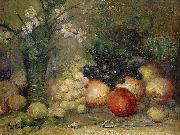 |
Emma Ekwall -- Click Here
|
|
painted Stilleben med frukter in 1838-1925 |
|
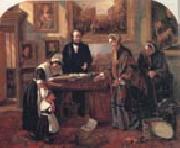 |
Emma Brownlow King -- Click Here
|
|
British, 1832-1905 |
|
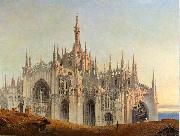 |
Emilio Magistretti -- Click Here
|
|
(Milan, 1851 - 1936) was an Italian painter.
Magistretti studied at the Brera Academy of Fine Arts from 1871 to 1875 under the guidance of Francesco Hayez and then accompanied him on his Italian journey of 1879. He worked initially in a range of different areas, from genre scenes to religious subjects and perspective painting, and successfully tried his hand at painting portraits, animals and landscapes at the turn of the century. He began to establish his reputation as an artist in 1880, when he was awarded a prize by the Ministry of Education, and became well known as a painter of moderately naturalistic portraits particularly appreciated by the middle-class establishment. An autobiography richly illustrated with reproductions of his most celebrated works was published in 1926.
|
|
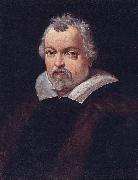 |
Emilian School -- Click Here
|
|
painted Ludovico Carracci in 17th century
|
|
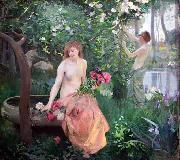 |
emile-Rene Menard -- Click Here
|
|
(1861 - 1930) was a French painter born in Paris. From early childhood he was immersed in an artistic environment: Corot, Millet and the Barbizon painters frequented his family home, familiarizing him thus with both landscape and antique subjects.
Menard studied at the Academy Jullian from 1880 after having been a student of Baudry, Bouguereau, and Henri Lehmann. He participated in the Salon of the Secession in Munich, and the Salon de la Libre Esthetique in Brussels during 1897. Several personal exhibitions were also devoted to him at the Georges Small Gallery. In 1921 he exhibited in the Twelfth Salon along with Henri Martin and Edmond Aman-Jean. Galleries in Buffalo, New York and Boston, Massachusetts exposed Menard and his art to the United States. However, the numerous commissions that Menard received from the French government crowned his career; for example, the cycle for the Hautes Etudes e la Sorbonne, the Faculte de Droit, and the fresco Atoms for the Chemistry institute, and finally the Caise des Depôts in Marseilles.
Menard's art allies a rigorous, clear classicism with a diffuse and dreamlike brushwork. In 1894, Victor Shoe wrote of Menard in l' Art et la Vie (Art and Life): "visions of a pacified, bathed nature, of dawn and of twilight, where the soul seems to immerse itself in the innocence of daybreak, and breathe the divine anointment that comes with the dawn."
|
|
|
|
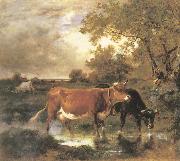 |
Emile Van Marcke de Lummen -- Click Here
|
|
1827-1890
Emile van Marcke was born in S??vres - into a family of artists. His father was Jean-Baptiste (1797-1848), the eldest son of Charles van Marcke and a painter who specialized not only in landscape and animal paintings, but also works on porcelain. |
|
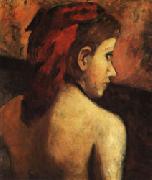 |
Emile Schuffenecker -- Click Here
|
|
French Post-Impressionist Painter, 1851-1934
French painter. In 1871 he entered the stockbroking firm of Bertin, where he met Paul Gauguin who was also employed there. In his spare time he took drawing classes and studied with Paul Baudry and Carolus-Duran, making his debut at the Salon in 1874. He also became acquainted with Armand Guillaumin and Camille Pissarro. Following the stock market crash of 1882, he, like Gauguin, was forced to leave Bertin and gained a job teaching art at the Lycee Michelet in Vanves. In 1884 he was one of the co-founders of the Salon des Independants and took part in the 8th and last Impressionist Exhibition in 1886, the year in which he also met Emile Bernard in Concarneau and sent him on to see Gauguin, thus initiating their joint development of CLOISONNISM. Though he mixed with the members of the Pont-Aven group his own artistic tastes were very different. While Gauguin and his disciples had little more than contempt for Neo-Impressionism, Schuffenecker was much interested in pointillist techniques. |
|
|
|
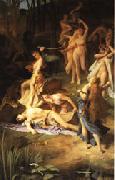 |
Emile Levy -- Click Here
|
|
Paris 1826 - Paris 1890.
French Academic Painter, 1826-1890.
Studied under François-Edward Picot and Abel de Pujol. |
|
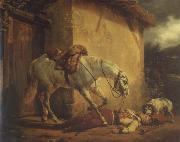 |
Emile Jean Horace Vernet -- Click Here
|
|
French, 1789-1863,Painter, son of Carle Vernet. He was born in his father's lodgings at the Palais du Louvre, where his grandfather Joseph Vernet also lived; his maternal grandfather was Jean-Michel Moreau. To these antecedents and influences are ascribed the supreme ease of his public career, his almost incredible facility and his fecundity. His early training in his father's studio was supplemented by formal academic training with Francois-Andre Vincent until 1810, when he competed unsuccessfully for the Prix de Rome. He first exhibited at the Salon in 1812. In 1814 Vernet received the Legion d'honneur for the part he played in the defence of Paris, which he commemorated in the Clichy Gate: The Defence of Paris, 30 March 1814. |
|
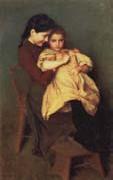 |
Emile Friant -- Click Here
|
|
French Realist Painter, 1863-1932, Was a French painter. With a naturalist style Emile Friant painted quotidian scenes involving people. His creations are characterized by the photographic realism of the human skin portions, and a less defined portrayal of the rest of the scene. |
|
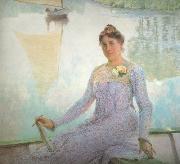 |
Emile Claus -- Click Here
|
|
Belgian Painter, 1849-1924
Belgian painter. He had various menial jobs before the composer Peter Benoet persuaded his father to let him study at the Koninklijke Academie voor Schone Kunsten in Antwerp. He was taught there by Nicaise De Keyser and Jacob Jacobs (1812-79) but found the atmosphere uncongenial and soon left. In 1879 he travelled around Spain and North Africa and in 1881 went to live with his sister at Waereghem. His painting of this period was influenced by Charles Verlat and depicted rural subjects |
|
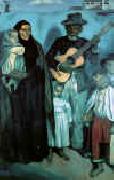 |
Emile Bernard -- Click Here
|
|
1868-1941
French
Emile Bernard Galleries
(b Lille, 28 April 1868; d Paris, 15 April 1941). French painter and writer. He was the son of a cloth merchant. Relations with his parents were never harmonious, and in 1884, against his fathers wishes, he enrolled as a student at the Atelier Cormon in Paris. There he became a close friend of Louis Anquetin and Toulouse-Lautrec. In suburban views of Asnires, where his parents lived, Bernard experimented with Impressionist and then Pointillist colour theory, in direct opposition to his masters academic teaching; an argument with Fernand Cormon led to his expulsion from the studio in 1886. He made a walking tour of Normandy and Brittany that year, drawn to Gothic architecture and the simplicity of the carved Breton calvaries. In Concarneau he struck up a friendship with Claude-Emile Schuffenecker and met Gauguin briefly in Pont-Aven. During the winter Bernard met van Gogh and frequented the shop of the colour merchant Julien-Franois Tanguy, where he gained access to the little-known work of Cezanne. |
|
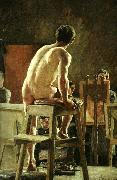 |
emil osterman -- Click Here
|
|
male model and pupils. ca. 1892
royal academy of fine arts |
|
 |
Emil Orlik -- Click Here
|
|
(July 21, 1870 - September 28, 1932) was born in Prague, which was at that time part of the Austro-Hungarian Empire, and lived and worked in Prague, Austria and Germany. He was a painter, an etcher and lithographer.
In 1905 Emil Orlik moved to Berlin and took a post at the "School for Graphic and Book Art" of the Museum of Decorative Arts (Kunstgewerbemuseum), now part of the Berlin State Museums.
|
|
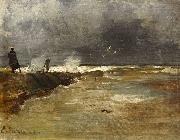 |
Emil Neumann -- Click Here
|
|
painted Strandspaziergang bei Wellengang in 1890 |
|
|
|
|
| | |
|
|
|
|